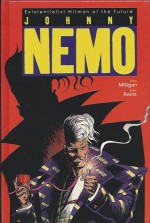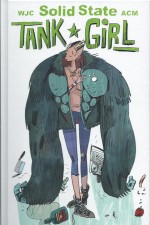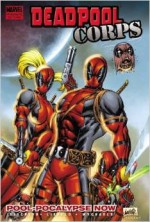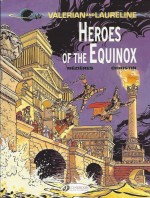
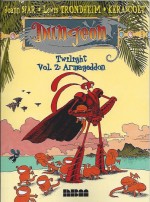
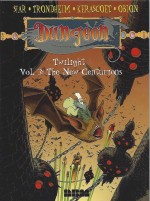
By Joann Sfar & Lewis Trondheim, Kerascoet & Obion, translated by Joe Johnson (NBM)
ISBNs: 978-1-56163-460-6, 978-1-56163-477-4 & 978-1-56163-578-8
As cunningly crafted by prolific artisans Joann Sfar (Professeur Bell, Les olives noires, The Rabbi’s Cat) and Lewis Trondheim (La Mouche, Kaput and Zösky, Little Nothings) with assorted associates of their New Wave-ish collective of bande dessinée creators – most often seen under the aegis of independent publisher L’Association – the Donjon saga has generated more than thirty interlinked volumes since it launched in 1998 and has become a massive cult hit all over the world.
These slim, translated (and re-released-in-one-complete-3-book-package) tales form a mere sub-division of a vast, generational, eccentrically raucous and addictively wacky franchise which welds starkly adult whimsy to the weird worlds of fantasy fiction, and these Twilight tomes take the loony legion of horribly human anthropomorphic characters into territories even wilder than those seen in Dungeon Early Years, Parade, Zenith, Monstres and Twilight.
All wholly defined sub-series of a truly vast epic, these all offer time-separated glimpses of a fantastic magic castle on the magically unstable world of Terra Amata. Inhabitants of this weirdly surreal universe include every kind of talking beast and bug as well as monsters, demons, smart-alecs, wizards, politicians and stroppy women-folk. Whenever and wherever you look there’s always something happening and it’s usually quite odd…
The nominal star is a duck with a magic sword which enabled – and eventually compelled – him to channel and be possessed by dead heroes and monsters. By this declining period on a dying world former hero Herbert of Craftiwich has risen to the unassailable rank of Grand Khan – though he’s still not quite sure how – and the doddering but still puissant old guy is steeped in Total Evil…
Crafted entirely by Sfar & Trondheim, Volume 1: Dragon Cemetery is composed of two original French albums (Donjon Crepuscule: Le Cimetiere des Dragons and Le Volcan des Vaucanson) from 1999. At this time the globe has ceased to spin, with one half eternally seared by light whilst the obverse is frozen into chilled darkness. Life only thrives on the narrow band between the extremes but is as harsh and unforgiving as it ever was…
When a little talking bat is enticed to become the eyes of immortal blinded dragon and political exile The Dust King, the act prompts a cascade of events which will shake and shatter the dying world. The unchanging saurian is a mage of incredible power under perpetual house arrest on the orders of the Khan and, ravaged by ennui, has decided to die at last…
Although Dust King has decided to end it all he is still too mighty for simple suicide. He needs to journey to a special place and requires a little assistance…
He and the Khan were once great friends, but over intervening years the potentate has become increasingly wicked and isolated by a coterie of unctuous, ambitious hangers-on and would-be usurpers.
The dragon’s decision has been detected at the Black Fortress of Gehenna by one of those parasites and vile functionary Shiwomeez fiendishly facilitates the prisoner’s escape. The tedious journey is soon being scrupulously monitored by the malign major domo who despatches waves of military goons with orders to await an opportune moment to strike. The last unit also have instructions to eradicate the sundry soldiery. The plotter believes the old wizard is travelling to the legendary and mystically significant “Dragon’s Graveyard†and doesn’t want too many menials knowing its location…
The trek is more complex than the sneaky pursuers realise. The Dust King needs the assistance of elusive shaman Orlandoh to pass over and is keenly aware that he is being followed. When he catches a crazy red rabbit warrior named Marvin the Destroyer he acts with precipitate haste and almost ends a willing would-be ally…
The obnoxious newcomer – named for a mighty killer of ancient times – attaches himself to the expedition and is stunned to find he is travelling with an old warrior who once also went by the legendary name Marvin…
After finally finding Orlandoh, the Dust King’s necropolitan journey takes a strange diversion and before long the pilgrims are battling Shiwomeez’s murderous minions and a host of diminutive horrors known as Olfs in their colossal citadel of Poopooloo. At long last the trek ends and the original Marvin prepares to let everything go…
However, events take a bizarre turn after the schemer’s mystic meddling accidentally drags long-eared young Marvin and the bitty bat to the Black Fortress where the crimson crusader’s manic skill with a sword causes utter carnage…
Not only is the pitiful plotter unable to stop the intruder but Shiwomeez also disturbs the long-distant Grand Khan, calling him back to the mundane world… and the overlord seems to know everything…
Casually blasted back to the Dragon Cemetery, Marvin and the bat can only await further developments…
The Dust King’s demise isn’t going well and after awhile the blind antediluvian gives up attempting to expire. Deciding to find what has become of his odd acolytes, the testy titan stumbles across red rabbit Marvin dallying with some rather lascivious cat women.
The ancient mage has an announcement: seemingly emboldened by his brush with death he has decided to force a meeting with his old friend the Khan. All they have to do is retrace their wearisome path and fight their way through the legions of warriors determined to stop them…
The expedition results in a vast pile of exotic corpses but one fine day old Marvin and his former friend Herbert have their long-deferred conference. The Dust King pleads with the Grand Khan to renounce Evil and his ultimate power. Of course if he does Terra Amata will begin to rotate again and soon explode…
Naturally Herbert refuses and with no other option The Dust King tries to kill him. The cataclysmic clash ends inconclusively and Herbert, mentally displaced by one of the many monsters which periodically possess him, gives orders for the blind beast and his puny companions’ capture and execution…
Fleeing on giant war-bats into the nocturnal zone the trio soon arrive at the troubled military outpost of Craftiwich, built on a huge volcano. The site is an armoury operated by fanatical duck soldiers, ruled by the Grand Khan’s son Arch-duke Papsukal. It also houses Herbert’s ogre son Elyacin and his libidinous, troublesome daughter Duchess Zakutu. There’s no love lost between this father and these children…
Papsukal is developing firearms and explosive ordnance, and to make conservative warriors give up swordsmanship he’s ordered that all smiths are to be hunted down and destroyed…
Pretending to be an envoy from the Grand Khan, bunny Marvin tricks the military technicians into fitting him with the first fully functional suit of nitro-powered super armour…
His impersonation – and assignation with the sexually voracious but insecure Zakutu – come a cropper, however, when the Khan arrives at the head of an army and resumes his death duel with the Dust King…
Illustrated by Kerascoet, the saga resumes in Volume 2: Armageddon (containing the French albums Donjon Crepuscule: Armageddon and Les Dojo du Lagon from 2002 and 2005) with the fugitives hiding out in the village of the cat women. The Dust King had been terribly maimed in his struggle with the Khan but was still unable to die and had regained a terrible power which he anticipated would come in most useful when their pursuers finally caught up with them…
Packing the women off with Red Marvin as guardian, The Dust King stays to meet the deadly duck forces. The result is the end of the Khan’s army and ambitions but in the aftermath, as birdlike shaman Gilberto helps the dragon and his faithful little bat hunt down his missing limbs, the surface of Terra Amata detonates, fragmenting into thousands of tiny floating islands above a core of lava…
Jaunting from islet to islet the mystic duo eventually track down old Marvin’s missing parts before landing in the remnants of once-formidable Poopooloo. Here they encounter no Olfs but a far more deadly, invisible threat…
Pausing only to pillage a vast store of magic botanicals and thaumaturgic vegetable pharmaceuticals, the voyagers flee the hidden horrors but blunder into the free-floating Olf bastion of Boobooloo where they are condemned to death…
Whilst awaiting execution the emotionally repressed Dust King shares some of Gilberto’s plundered stash and in a traumatic daze relives the dogmatic days of dragon philosophy which lost him his family and the subsequent event which cost him his eyes…
When he comes to his senses again the Olf courtroom is a shredded, burning wreck and what few survivors remain are fleeing in terror. Gilberto too has swallowed too many drugs and is stricken with a debilitating parade of incredible new powers. One of them makes him a perfect predictor of every floating island’s path whilst another inflicts random, uncontrollable teleportation upon him…
Forced to escape by more prosaic means (at least by Terra Amata standards), old Marvin and his bat buddy find their way to Orlandoh and the drifting Hut of Spirits to await fate’s next move…
One day Red Marvin turns up and is promptly recruited as the Dust King and shamans of the Spirit Hut make plans to combat the remnants of the Grand Khan’s forces. Despatched on an infiltration to the rapidly approaching remnants of Craftiwich, the dry old lizard unexpectedly goes off the reservation and drags his bunny disciple to a passing islet inhabited by dragons. As the bunny makes eyes at a reptilian firebrand who subsequently swipes his super-armour, the elder Marvin is meeting a seductive sorceress who was once, so long ago, his wife…
The Dust King is desperate to amend the sacrilege which drove them apart and is astounded when he meets his grandchildren. The rabbit meanwhile has joined a school of dragons learning how to be true warriors. Sadly, he is having trouble being taken seriously by the colossal students, let alone their grizzled old tutors. It takes a few pointers from the crestfallen Dust King to make the mockers pay proper attention to his eager friend…
And once he’s got them listening, the saurian sage goes about dismantling the doctrinaire dragon religion which cost him his love, his children and his eyes before the heroes return to their shamanic mission in time to rescue Duchess Zakutu from a parched death.
However taking the faithless trollop back to the dragon isle proves a big – almost fatal – mistake for the besotted rabbit…
Volume 3: The New Centurions
The final volume starts with the world’s various exotic survivors eking out a perilous existence on isolated islands chaotically afloat hundreds of metres above a global sea of molten lava…
Again comprising two translated albums it all kicks off with ‘The New Centurions’ (formerly Donjon Crepuscule: Nouveaux Centurions from 2006 illustrated by the delightfully adroit Kerascoet). Herbert has lost much of his might and is being increasingly bullied by his advisors. Moreover his kids have also joined the ranks of those trying to remove him…
The Dragon students forge a tenuous association with the ducks of Craftiwich and are being fitted with flying armour as the vanguard of a new type of super-soldier ,but carmine lepine Marvin has started to chafe under the Machiavellian intrigues and back-biting which dominate life in the ruined court-in-exile of the Khan. Tasked with training assorted soldiery who still won’t take a rabbit-warrior seriously, yet keenly aware that the vultures are circling, boy Marvin knows that when the take-over attempt by Herbert’s double-dealing lieutenant Fayez begins, no one will be ready…
Inevitably that day comes and the usurpers are victorious, even though Herbert survives to regroup: however mammal Marvin and his mentor Marvin the dragon are fed up with the whole interminable push-and-shove of politics and promptly quit.
Sneaking away they go looking for some uncomplicated adventuring among the floating Islands in the Sky…
In ‘Revolutions’, with art by Obion, the nomadic duo become stranded on a giant chunk of land slowly rotating in a downward spiral. With their flying beast dead and Marvin’s armour lost to carnivorous grass the wanderers are forced to continually climb upwards just to stay in place. The alternative is a rapid and terminal plunge to the surging lava-lakes below…
Eventually they come across a group of bears and other unfortunate creatures endlessly hauling a gigantic villa and attendant gardens in a circle around the tiny world, keeping everything one step ahead of the rotational doom.
Why do the bedraggled and exhausted volunteers pull so determinedly? Is it for the eight hours of rest and sustenance in the paradisiacal arbours they are granted every third shift? Is it the favours of the willing women of tiny Lord Takmool‘s family? Or is the diminutive aristocrat simply the slyest snake-oil salesman and most duplicitous capitalist conman in the universe?
The Dust King is not so easily fooled but even he eventually joins the eager Marvin on the team – it is, after all, the only game in town. However this Garden of Eden supplies its own temptations and serpents and the darkly satiric allegory looks set to come to a bloody end until unexpected catastrophe strikes the entire island and a whole new world comes into being in the spectacular aftermath…
Surreal, earthy, sharp, poignant, hilarious and brilliantly outlandish, these wittily sophisticated fantasy comedies are subtly addictive to read whilst the vibrant, wildly eccentric cartooning is an absolute marvel of exuberant, graphic style. Definitely not for the young reader, Dungeon Twilight is the kind of near-the-knuckle, illicit and just plain smart read that older kids and adults of all ages will adore, but for a fuller comprehension – and even more insane fun – I strongly recommend buying all the attendant incarnations too.
© 1999, 2002, 2005, 2006, 2009 Delcourt Productions-Trondheim-Sfar-Kerascoet-Obion. English translation © 2006, 2010 NBM.

